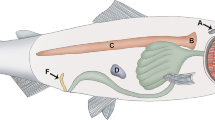Summary
Compared to adults, the oxygen affinity of blood from fetalSphenomorphus quoyii is very much higher:P 50 is approximately 70 Torr in adults and 30 Torr in nearly full term embryos\((P_{CO_2 } = 17 Torr, T = 34 ^\circ C)\). Following birth, oxygen affinity decreases gradually and adult values are approached after about 15 weeks, with the onset of winter retreat. Electrophoresis revealed a multiple hemoglobin system in both adults and embryos, but there were no apparent differences between them.
Similar content being viewed by others
References
Amoroso EC (1968), The evolution of viviparity. Proc R Soc Med 61:1188–1198
Baumann R, Baumann FH (1978) Respiratory function of embryonic chicken hemoglobin. In: Piiper J (ed) Respiratory function in birds, adult and embryonic: Springer, Berlin Heidelberg New York
Bennett AF (1973) Blood physiology and oxygen transport during activity in two lizards,Varanus gouldii andSauromalus hispidus. Comp Biochem Physiol 46A:673–690
Bonaventura C, Sullivan JB, Bonaventura J (1974) Effects of pH and anions on functional properties of hemoglobin fromLemur fulvus fulvus. J Biol Chem 249:3768–3775
Farmer M, Weber RE, Bonaventura J, Best RC, Domning R, Magor D (1979) Functional properties of hemoglobin and whole blood in an aquatic mammal, the Amazonian Manatee (Trichechus inguinis) Comp Biochem Physiol 62A:231–238
Garlick RL, Davis BJ, Farmer M, Fyhn HJ, Fyhn UEH, Noble RW, Powers DA, Riggs A, Weber RE (1979) A fetal-maternal shift in the oxygen equilibrium of hemoglobin from the viviparous caecilian,Typhlonectes compressicaudata. Comp Biochem Physiol 62A:239–244
Grigg GC, Gruca M (1979) Possible adaptive significance of low red cell organic phosphates in crocodiles. J Exp Zool 209:161–167
Hazard ES, Hutchison VH (1978) Ontogenetic changes in erythrocyte organic phosphates in the Bullfrog,Rana catesbeiana. J Exp Zool 206:109–118
Heatwole H (1976) Reptile Ecology. University of Queensland Press, St. Lucia, Queensland
Hogarth PJ (1976) Viviparity. Arnold, London
Lykkeboe G, Johansen K (1978) An O2-Hb ‘paradox’ in frog blood? (n-value exceeding 4.0). Respir Physiol 35:119–127
McCutcheon FH (1947) Specific oxygen affinity of hemoglobins in clasmobranchs and turtles. J Cell Comp Physiol 29:333–344
Manwell CP (1955) A study of the hemoglobins of some snakes of the genusThamnophis. Thesis, University of Washington
Manwell CP (1958) A “fetal maternal shift” in the ovoviviparous Spiny DogfishSqualus suckleyi (Girard). Physiol Zool 31:93–100
Manwell CP (1960) Comparative physiology: blood pigments. Ann Rev Physiol 22:191–244
Pough FH (1969) Environmental adaptations in the blood of lizards. Comp Biochem Physiol 31:885–901
Pough FH (1971) Ontogenetic changes in oxygen-transport properties of blood of garter snakes,Thamnophis sirtalis. Am Zool 11:207
Pough FH (1977) Ontogenetic changes in molecular and functional properties of blood of Garter Snakes,Thamnophis sirtalis. J Exp Zool 201:47–56
Powers DA, Fyhn, HJ Fyhn VEH, Martin JP, Garlick RL, Wood SC (1979) A comparative study of the oxygen equilibria of blood from 40 genera of Amazonian fishes. Comp Biochem Physiol 62A:67–85
Riggs A (1951) The metamorphosis of hemoglobin in the bullfrog. J Gen Physiol 35:23–40
Thompson J (1977a) Embryo-maternal relationships in a viviparous skink,Sphenomorphus quoyii (Lacertilia: Scincidae). In: Calaby JM, Tyndale-Biscoe CH (eds) Reproduction and evolution. Australian Academy of Science, Canberra, pp 279–280
Thompson J (1977b) Embryo-maternal relationships in a viviparous lizard,Sphenomorphus quoyii (Dumeril and Bibron). PhD Thesis, University of Sydney
Toews D, MacIntyre D (1977) Blood respiratory properties of a viviparous amphibian. Nature 266:464–465
Weekes HC (1933) On the distribution, habitat, and reproductive habits of certain European and Australian snakes and lizards with particular regard to their adaptation of viviparity. Proc Linn Soc NSW 58:270–274
Weekes HC (1935) A review of placentation among reptiles with particular regard to the function and evolution of the placenta. Proc Zool Soc (Lond) 2:625–645
Author information
Authors and Affiliations
Rights and permissions
About this article
Cite this article
Grigg, G.C., Harlow, P. A fetal-maternal shift of blood oxygen affinity in an Australian viviparous lizard,Sphenomorphus quoyii (Reptilia, scincidae). J Comp Physiol B 142, 495–499 (1981). https://doi.org/10.1007/BF00688981
Accepted:
Issue Date:
DOI: https://doi.org/10.1007/BF00688981




